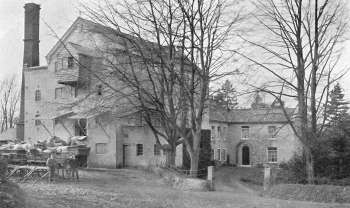 |
|
15th
February 1905
|
|
Gressenhall
Chappell Mill River Whitewater (trib of River Wensum) |
 |
|
15th
February 1905
|
|
Gressenhall
Mill was also known as Chappell Mill, taking its name from the nearby Chapel
of St Nicholas. The mill was built on an ancient site that has been traced
back to the time of Edward the Confessor. After the Norman conquest it
became part of William de Warren's estate, when in 1088 he was created Earl of Surrey and given lands in 13 counties (though curiously none in Surrey). These lands comprised of 233 parishes of which 116 were in Norfolk. In modern money his holdings would be worth some £57 billion - a record in Britain during the last millennium. He died in the same year of 1088, shot by an arrow. |
In 1847, the final mill to be erected on the site was built by Robert Stammers jnr whose father Robert Stammers snr had previously run the Pockthorpe_Magdalen_Road_postmill in Norwich. The new building was mainly of rendered brick with a Norfolk pantiled roof. |
The parish boundary between Gressenhall and Hoe runs down the centre of the river as it does in many parishes. The boundary takes the line through the centre of the wheelrace and in the early days, this put the mill machinery and therefore the mill, in the parish of Gressenhall. By the time of William Mussett's will in 1759, the building had been extended over the Hoe side with additional millstones and possibly a second wheel being added. Thus there was a mill in each parish under one roof. |
Chappell mill had a breastshot 18 ft. wheel that was 7 ft. 6 ins. wide with iron buckets set 21 ins. apart. The wheel was set in the river between the Gressenhall mill (later the Mill House) and the Hoe mill (later burnt down). The 5 ft. head of water provided approx. 16 h.p. in normal winter conditions but 40 h.p. could have been possible in flood conditions were it not for the resulting rise of water in the mill pool impeding the wheel. |
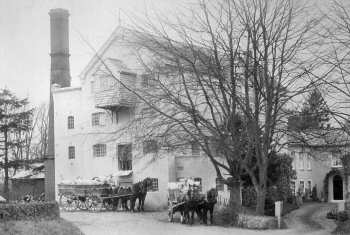 |
|
Carts
leaving the mill 15th February 1905
|
|
William Wilson of Gressenhall, miller, to be discharged of Catherine Troyddy, his apprentice, and to take Ann Doro instead. To repay to Gressenhall 30/-, part of the moneys received with Troyddy who is to be sent home to her parents. |
|
Robert (de Stutevill) married Joan daughter & heir of William Talbot of Gainesburgh in Lincolnshire & died seized of this town held of the Earl Warren by 2 knights fees in the first year of King Edward I viz. a capital messuage, a water mill, a windmill, 200 acres of pasture, a KAR etc. all valued at £19. 3. 4d. |
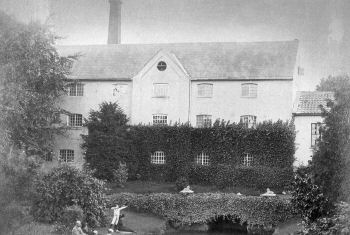 |
|
Tailrace
c.1910
|
|
WILLS proved in NORWICH CONSISTORY COURT |
Royal Exchange Fire Insurance policy 77495 |
Robert Child of Grefsenhall in the County of Norfolk, Flour Merchant. On Furniture in his Dwelling House brick built and Thatchd situate in Grefsenhall aforesaid, £50. Trade in the same & in the Water Corn Millhouse adjoining Thatchd & on the fixed & moveable utensils therein, £350. 16th February 1780 |
To be Sold by Auction, |
|
On Friday the 11th Day of October, 1782, between the Hours of Three and Five o'Clock in the Afternoon, at the King's Arms Inn, in East Dereham, in Norfolk, by Order of the Assignees of the Estate of John Curties, the Younger, a Bankrupt, if not before disposed of by private contract. Lot 1. An Estate in Gressenhall, in Norfolk; consisting of a Messuage, large Farm-yards, Gardens well planted with Fruit Trees, two Bark Barns, one Corn Barn, large Drying-shed, with Granary over it, Leather-house, Mill-house, Kiln-house, Scouring-house, Turf and Tan-houses, Cart and Waggon-shed, and other Buildings, all in good Repair, and several Closes of rich Arable and Pasture Land contiguous to the said Messuage, containing by Estimation thirty Acres, more or less. The tanning-office is very conveniently situated for several Market Towns, being only two Miles from East Dereham, the Centre of Norfolk, ten from Fakenham, and eleven from Swaffham. Also a Messuage in Gressenhall aforesaid, wherein William Darby and Thomas Cropley live, with Outhouses, Yard, and Garden thereto belonging. Norfolk Chronicle - 21st September 1782 |
|
Whereas a Commission of Bankrupt has been awarded and issued against William Hoogan MILLS and John ADAMS late of Gressenhall, Corn Millers, Dealers and Chapman and Partners, and having been declared Bankrupts they are hereby required to surrender ... 21 Day of September instant ... |
When the owner, Rvd. Cuthbert Beacon died, his wife inherited his estate and when she later married Edmund Jermy, he became the mill owner in right of his wife. |
To be Sold by Auction. |
|
In 1795, Gressenhall Mill was worked in conjunction with 'a good windmill near the same' and in later years with a smockmill. |
The Directors & Guardians of the workhouse leased the Union Farm to Henry Hastings and in 1825 they leased him the Workhouse windmill along with 51 acres of land for £100 per annum. |
John Whiteman sold the Hoe side of the mill to Henry Hastings some time before 1844, when in the Tithe Award, he was listed as owner and occupier. Henry Hastings also leased the Gressenhall side and was thus running the whole enterprise a the time of his death. |
|
After the 16th century the mill house was added along with barns, stables and cottages. |
On 14th September 1869, Robert Stammers jnr's daughter Harriet Rivett Elizabeth married Arthur Massingham, by license, there being 87 witnesses to the marriage. Arthur was the son of Davey Massingham, bank clerk. Harriet had been baptised in 1827. |
|
To JOURNEYMEN MILLERS |
In 1894 Robert Stammers jnr's executors added an additional floor taking the total to 4 storeys, heightened the chimney and installed a 3 sack/hour roller plant, making the mill one of the most up to date in the country. |
|
The mill employed a number of hands among whom were the late Cyril Norton of Hoe. When he was eighty seven he told me what he remembered of the old mill with its water wheel and stones and mentioned some of the old-time characters who worked there in Mr. Herbert Stammers' day. |
At 11.20pm on Friday 16th October 1914, the mill caught fire. An hour and a half later Dereham Fire Brigade arrived. During the four hours that the fire lasted, 200 to 300 sacks of flour were destroyed along with a large quantity of wheat, reported to be about 1,500 sacks. The glow from the terrific sheets of flame could be seen in Norwich some 18 miles away. The building was totally gutted with damage estimated at between £6,000 - £7.000.. |
The insurance covered the building of a new 5 sack roller mill at Dereham beside the railway near Lynn Hill, which traded as H. C. Stammers & Co. As directors, Ernest Pallett, Philip Sayer and Robert Sayer won the Gold Medal at the London Exhibition for the Millers' Cup in 1930 for flour quality. By 1965 flour milling had been replaced by animal feed milling after another fire. |
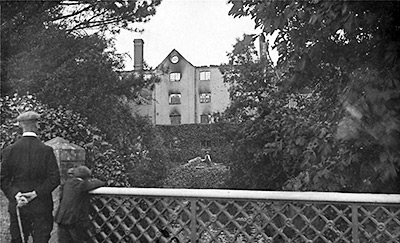 |
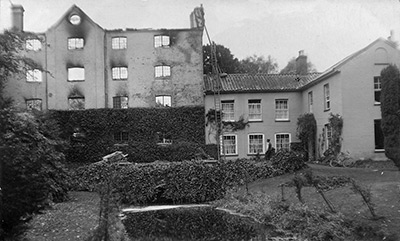 |
After the fire October 1914 |
|
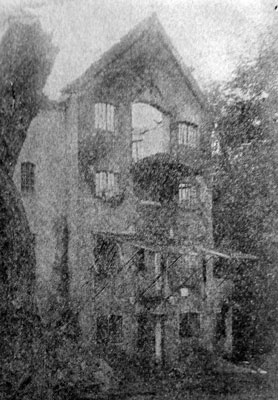 |
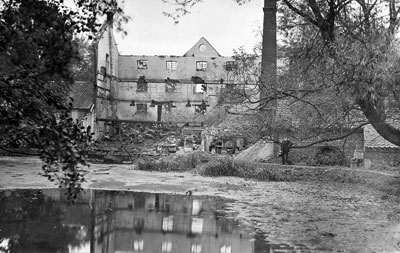 |
Loading area gable 1914 |
The mill dam and building shell in October 1914 |
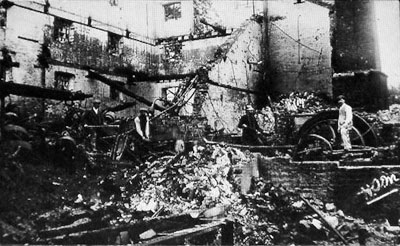 |
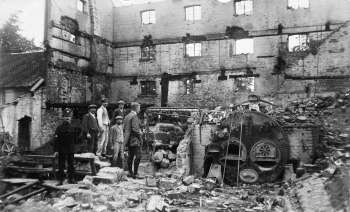 |
|
Internal
remains including the steam boiler 17th October 1914
|
|
 |
Internal
remains including the steam boiler 17th October 1914 |
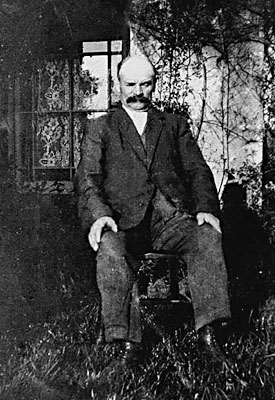 |
George Eglan - engine man c.1928 |
George Eglan went on to work in Dereham after the Gressenhall fire. |
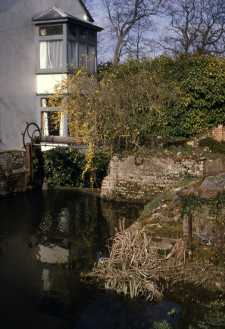 |
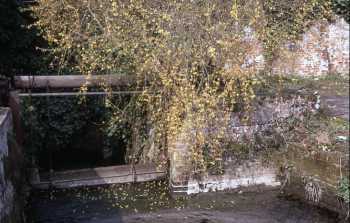 |
|
March 1967
|
The
wheel sluice in March 1967 |
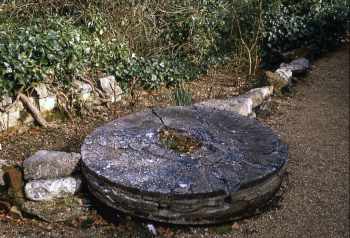 |
|
French burr
millstone March 1967
|
|
Robert Stammers (1818-1885) born Norwich and died at Gressenhall as a miller, seems to have occupied the mill from sometime after 1845 - previous tenant or owner John Hannent. Third son Herbert Chapman Stammers (1859-1928) took over the mill and at some date built a large steam mill near Dereham railway station which was later run by John Chapman Stammers (1897-1947). Robert Stammers' younger brother William (1820-1869) became a grocer and draper at Hempnall from whom I have descended. There were two other brothers John (1832 -?) and Joseph (1823-1862) both became millers. John probably at Wymondham, Browick Road mill (to be confirmed) and Joseph at Mendham. |
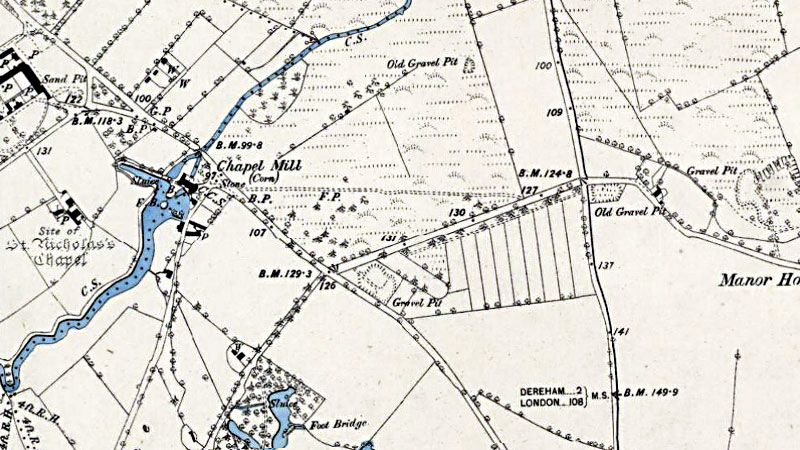 |
O. S. 6" Map 1883 (not to scale) |
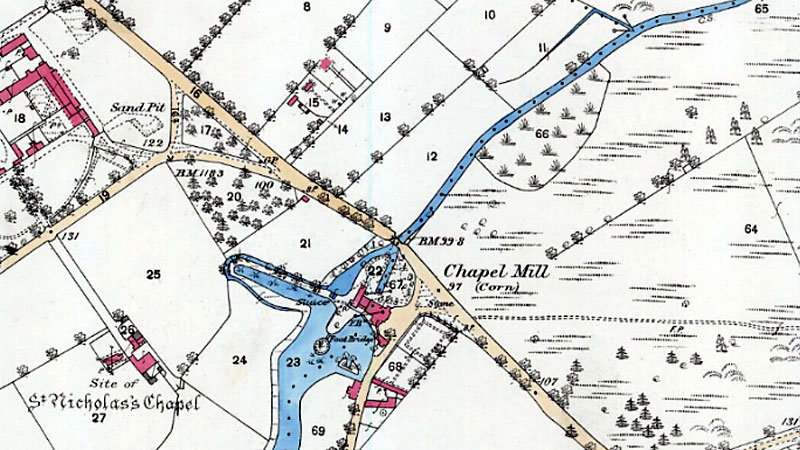 |
O. S. 25" Map 1883 (not to scale) |
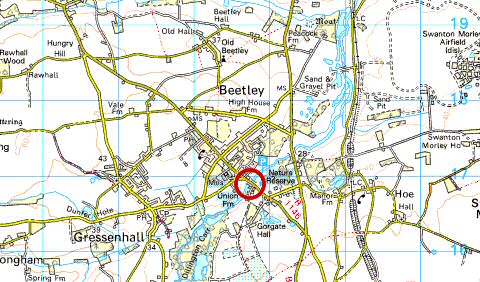 |
|
O.S. Map 2005 Image reproduced under licence from Ordnance Survey |
|
c.1060: Toke, Anglo Saxon thane and freeman of Gressenhall 1250: Chapel of St. Nicholas the Bishop founded
1299: Jordan Foliat, Lord of the Manor; Simon, miller
c.1784: William Hoogan Mills & John Adams
Kelly's 1912: H. C. Stammers & Co. millers, (water & steam) |
If you have any memories, anecdotes or photos please let us know and we may be able to use them to update the site. By all means telephone 07836 675369 or
|
| Nat Grid Ref TF 97761686 | Copyright © Jonathan Neville 2003 |